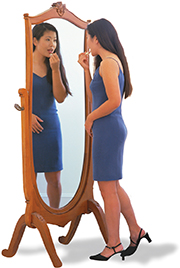Next time you are in a car behind a large truck, look for a sign that reads, “If you can't see my mirror, then I can't see you.” Light travels from you to the mirror to the driver's eyes and also from the driver to the mirror to your eyes. If you do not have a line of vision to the truck's side-view mirror, then the truck driver does not have a line of vision to you. It can be dangerous to drive too close to large trucks!
Plane Mirrors
Mirrors are usually made of a sheet of glass that is coated with a thin layer of shiny metal on one surface. A mirror with a flat surface is a plane mirror. The large mirror in your bathroom is a plane mirror. When you look into a plane mirror, you see your reversed reflection—a right-left reversed image of yourself. An image is a copy of an object formed by rays of light.
Figure 2 shows how a plane mirror forms an image. To produce your image in a mirror, rays of light strike you and reflect. These reflected rays then strike the mirror and are reflected into your eyes. The dashed lines show how your brain interprets where the rays are coming from. The rays appear to come from behind the mirror. Your image appears the same distance behind the mirror as you are in front, and the image is right side up. If you walk toward the mirror, you'll see your image also move toward the mirror.  A plane mirror always produces a virtual image. Although you can see a virtual image, this type of image cannot be projected onto any surface. A virtual image is a copy of an object formed at the location from which the light rays appear to come. It is important, however, to realize that the rays do not really come from behind the mirror.
A plane mirror always produces a virtual image. Although you can see a virtual image, this type of image cannot be projected onto any surface. A virtual image is a copy of an object formed at the location from which the light rays appear to come. It is important, however, to realize that the rays do not really come from behind the mirror.
Figure 2 The girl sees a virtual image of herself in the plane mirror. Virtual images such as this cannot be projected onto a screen. Note also how light rays from the object (the girl) reflect from the mirror's surface and obey the law of reflection. Interpreting Photos What do the dashed lines represent?

Quick Lab
Measuring the Height of Your Mirror Image
Materials
plane mirror, meter stick, newspaper, masking tape
Procedure 
Have a classmate measure and record your height in centimeters.
Stand directly in front of the mirror, 1 m away from it.
Look at your image in the mirror. Have a classmate tape newspaper over those parts of the mirror (above and below your image) where you do not see any part of yourself.
Measure and record the height of your image by measuring the uncovered part of the mirror.
Repeat Steps 3 and 4 for distances of 2 m, 3 m, and 4 m.
Analyze and Conclude
Analyzing Data How did the height of your image change as you moved farther away from the mirror?
Drawing Conclusions What is the relationship between your height and the height of your image in the plane mirror?




